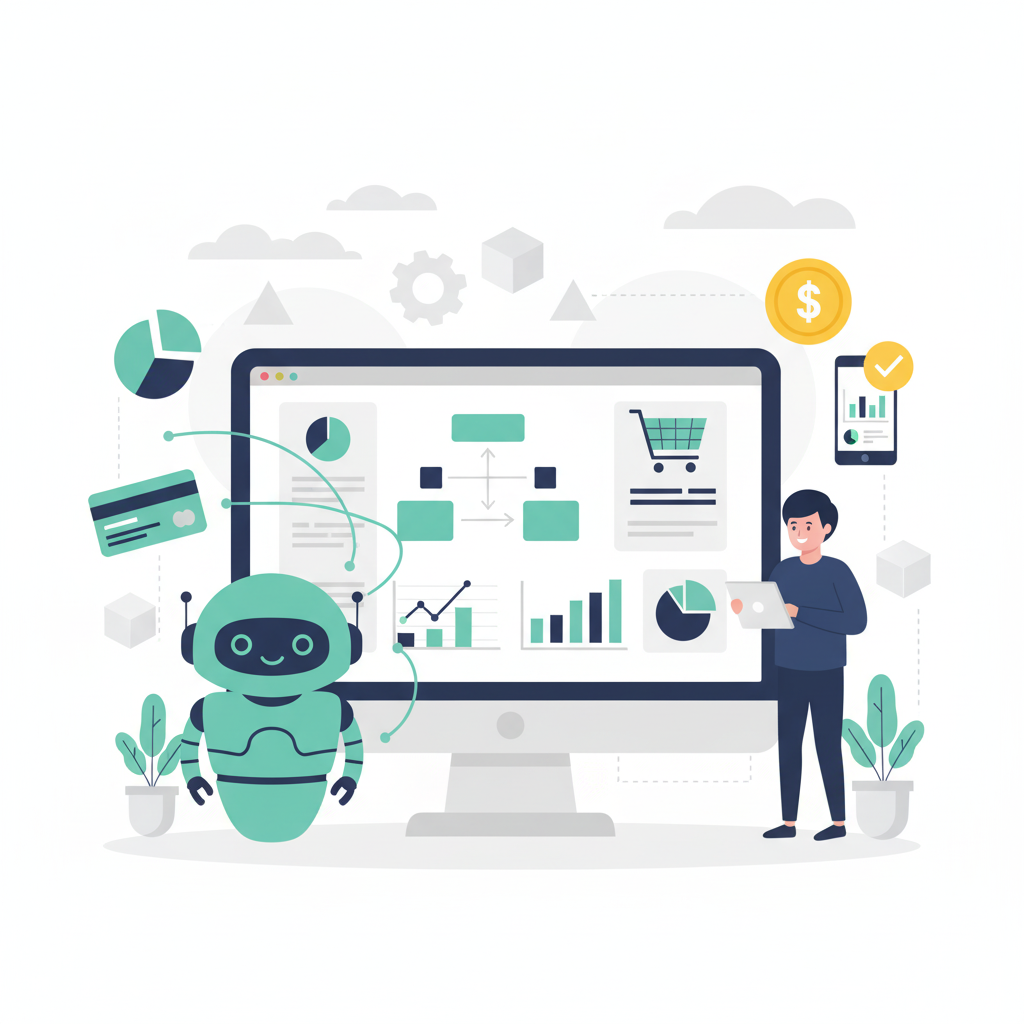PayPal and OpenAI just announced something big. We’re not talking about chatbots that suggest products and wait for you to hit “buy.” We’re talking about AI agents that handle the entire purchasing process by themselves.
This emerging application of autonomous systems represents a fundamental shift in how organisations compete. As we explore in our comprehensive guide to understanding AI agents and autonomous systems, agentic commerce exemplifies how autonomous decision-making moves from research laboratory to production at scale.
Traditional e-commerce automation hits a ceiling. You’re still making every final decision. Agentic commerce changes this. AI agents can autonomously select products, compare them, and complete purchases within boundaries you set. This opens up new revenue streams while you manage risk through transaction authority frameworks.
What Exactly is Agentic Commerce and How Does It Differ from Traditional E-Commerce Automation?
Agentic commerce is when AI agents make autonomous purchasing decisions on your behalf.
Traditional e-commerce automation stops at product recommendations. Agentic AI systems initiate autonomous action toward defined goals, interacting with APIs and databases with minimal oversight. Think of it this way – traditional automation is a GPS that gives you directions. Agentic commerce is a self-driving car that decides where to go.
The core difference is who has decision-making authority. With agentic commerce, the agent decides. With traditional automation, you decide and the AI helps. True agentic commerce agents handle product comparison, preference evaluation, and transaction execution by themselves within boundaries you define.
The PayPal-OpenAI integration shows this at scale – ChatGPT connected to 434 million PayPal accounts, enabling transactions without waiting for approval on each purchase.
Adore Me implemented agentic AI and saw a 40% increase in non-branded search traffic. They cut international market expansion from months to 10 days. Marketplace content creation dropped from 20 hours per month to 20 minutes. That’s real impact.
What Are the Main Types of AI Agents Used in Business Today?
AI agents exist on a spectrum. You’ve got simple reflex agents on one end and sophisticated autonomous agents on the other. Understanding where each type fits helps you match agents to business requirements. For deeper context on agent architecture and autonomy characteristics, see our primer on distinguishing real AI agent autonomy from agent washing.
Reflex agents use predefined rules for immediate decisions. They’re good for basic filtering and price comparisons but they can’t handle complex preferences or trade-offs.
Autonomous agents employ reasoning with user preference learning and independent decision-making. After an initial prompt, they continue working without further input, which reduces the need for human intervention. These are what you need for true agentic commerce, but you’ll also need robust governance frameworks to keep them in check.
Multi-goal agents balance competing objectives like price versus quality versus delivery speed. They’re required for realistic shopping where customers care about multiple factors.
Background commerce agents continuously monitor prices, inventory, and your preferences. They execute transactions proactively without real-time interaction, transforming agentic commerce from reactive to 24/7 passive shopping.
But here’s the thing – agentic AI currently demonstrates significant capabilities alongside implementation immaturity. Many early enterprise deployments report a gap between vendor promises and what actually gets delivered.
What’s the Significance of the PayPal-OpenAI Partnership Announced in October 2025?
The October 28, 2025 announcement is a big deal. ChatGPT integrated with PayPal’s 434 million user accounts, demonstrating agentic commerce adoption at scale.
This isn’t some startup experiment. This is a major payment processor enabling agent-driven transactions and addressing concerns about payment security and compliance. It’s market validation that customers are ready to grant purchasing authority to AI agents.
The partnership reaches consumers through ChatGPT directly, not through merchants. This creates new revenue channels for businesses that get in early and competitive pressure for those that lag behind.
OpenAI’s mature ecosystem supports complex multi-agent workflows through extensive integrations. This establishes a go-to-market pattern: LLM companies paired with payment processors and e-commerce platforms.
Many companies are grappling with agentic AI’s return-on-investment problem. That makes the PayPal-OpenAI partnership more significant—it’s real infrastructure, not just a vendor demo.
What Implementation Options Exist for Building Agentic Commerce Systems?
You’ve got three primary approaches: partnership integration (fastest but creates vendor dependency), custom agent development (flexibility and control), or orchestration platforms (vendor-neutral integration layer).
For partnership integration, the PayPal-OpenAI model gets you to market fastest if your customers already use ChatGPT and PayPal.
For custom development, the Claude Agent SDK provides developer-friendly tools for building autonomous agents with tool use, memory systems, and decision-making frameworks. This gives you vendor flexibility and long-term portability.
For orchestration, the n8n workflow automation platform lets you deploy rapidly through pre-built connectors to merchant systems, payment processors, and inventory databases.
There’s an Agentic Commerce Protocol emerging to enable interoperability between agent platforms and merchant systems, which protects you against vendor lock-in.
LLM model selection affects your reasoning capability, inference costs, and safety requirements. OpenAI GPT-5 costs $1.25 input and $10 output per million tokens. Anthropic Claude Sonnet 4 runs $3 input and $15 output. For a typical autonomous shopping decision involving product comparison across 10 items, you’re looking at approximately $0.15-0.30 per transaction with GPT-5.
How Do You Safely Scale Autonomous Shopping Agents While Managing Risk?
Transaction Authority Delegation defines what your agents can do—what transaction types, price ranges, product categories, and merchant partners they can execute independently. This is your fundamental risk boundary.
An Agent Governance Framework systematically defines, enforces, and monitors agent authorities. It creates audit logging for compliance and enables escalation workflows for edge cases.
Your A-Commerce Security Model combines encrypted user preferences, secure payment authorisation, transaction verification, fraud detection, and audit logging. The security model needs to address three concerns: can the agent access payment methods it shouldn’t? Can users review agent decisions before execution? How do you detect when an agent is making poor decisions?
Use multi-tier authority levels. Tier 1 covers low-value routine purchases with minimal oversight—things like subscription renewals or replenishing household consumables. Tier 2 handles medium-value transactions requiring preference confirmation. Tier 3 governs high-value purchases requiring human approval—anything above your defined threshold or outside established categories.
Implementing data governance, ownership models, and standardised APIs is necessary for AI readiness yet rarely gets adequate attention.
Agentic systems can trigger financial transactions and access sensitive data. Auditing agent behaviour, ensuring explainability, managing access control, and enforcing ethical boundaries remain immature practices across the industry.
Here’s something important – AI systems inherit existing permissions, potentially exposing sensitive information. Your data classification must accurately reflect sensitivity levels and compliance requirements.
Which Industries and Use Cases Show the Strongest ROI for Agentic Commerce?
ROI for agentic commerce varies significantly by industry. These sectors show the strongest business cases.
B2B Procurement Automation delivers the highest proven ROI through continuous vendor comparison, automated replenishment, and negotiation optimisation. Orchestration enables better contract compliance and reduces maverick spend. Organisations moving from 58% to 80% compliance can translate that into tens of millions in recurring savings.
Consumer Retail A-Commerce offers the largest transaction volume potential. The scale of the PayPal integration validates this market through extensive reach. AI uses behavioural signals, browsing history, cart activity, purchase frequency, and on-site clicks to tailor user experience in real time.
Travel and Hospitality Commerce enables sophisticated multi-parameter optimisation across flights, hotels, and experiences. Complex integration requirements justify premium agent pricing and vendor partnerships.
Supply Chain and Logistics Optimisation drives enterprise adoption. Background agents continuously optimise carrier selection and inventory reorder points with measurable cost savings. Predictive models forecast demand based on trends, seasonality, and promotions.
Insurance and Financial Services command high transaction values with complex governance requirements. Adoption will be slower than consumer retail but justified by regulatory compliance infrastructure and premium margins.
What Are the Major Vendor Platforms and Technology Choices in the A-Commerce Landscape?
Vendor selection depends on three factors: vendor lock-in risk tolerance, inference cost requirements, and safety and guardrail priorities. For a comprehensive evaluation framework comparing platforms and orchestration tools, review our detailed platform selection guide.
OpenAI dominates consumer-facing agentic commerce through the ChatGPT-PayPal integration, establishing the market standard for agentic commerce user experience and scale. But watch out for vendor lock-in risk in enterprise deployments.
The Anthropic emphasises security posture with data minimisation and constitutional AI for risk-averse enterprises. Claude Agent SDK provides an open-source alternative with emphasis on AI safety.
Google and Microsoft offer hosted platforms through Vertex AI Agent Builder and Copilot Studio. They provide enterprise support and integration ecosystems but their agentic commerce focus is fragmented.
n8n enables a vendor-neutral orchestration layer connecting agents to merchant systems, reducing custom integration development and mitigating PayPal-OpenAI lock-in.
E-commerce platforms like Shopify, Amazon, and eBay are beginning integration. This determines merchant accessibility to agent-driven sales channels.
An Agentic Commerce Protocol creates standardised interoperability, which lets you avoid single-vendor ecosystems. Forrester identifies nine dimensions of interoperability: tool use, inter-agent communication, identity and trust, memory, knowledge sharing, marketplaces, governance, discovery, and error handling.
Security posture assessment should drive platform choice: if existing security requires custom API integration, choose OpenAI; if data minimisation is a priority, choose Anthropic; if unified compliance simplifies governance, choose Google.
How Will Agentic Commerce Impact Customer Expectations and Competitive Positioning?
Customer Adoption Metrics like opt-in rates, transaction frequency, and authority levels signal market readiness and determine your realistic addressable market for agentic commerce investments.
Competitive pressure is increasing as early adopters demonstrate market traction. Laggards risk losing market position if competitors capture the autonomous shopping opportunity first.
Vendors marketing simple automation as “autonomous agents” create customer scepticism and differentiation opportunity for credible platforms. This agent washing creates noise but also lets you distinguish your platform through transparent governance and measurable autonomy.
Trust mechanisms shift from “the company kept me safe” to “I trust the AI agent I configured.” You need to show customers how agents make decisions, not just that they work.
Vertical differentiation matters. Financial services and healthcare demand higher governance transparency due to regulatory requirements. Consumer retail demands faster iteration and lower friction to compete on convenience.
Long-term positioning suggests agentic commerce adoption will become widespread by 2027. But many early enterprise deployments haven’t delivered forecasted gains. Agentic AI implementations often fail not due to technical limitations, but because they’re expensive, complicated, or misaligned with actual business problems. Understanding how to prevent the eighty percent failure rate and measure agent ROI properly becomes critical to ensuring your agentic commerce investment succeeds.
The winners won’t be those who adopt fastest, but those who prepare their enterprise best. Only 60% of companies have any AI policy. Governance and acceptable-use policies should come early—before deployment, not after problems emerge.
FAQ Section
What’s the difference between agentic commerce and traditional chatbot shopping assistants?
Agentic commerce grants autonomous decision-making authority to AI agents. Chatbot assistants provide recommendations but require human approval for each purchase. True agentic commerce agents handle product comparison, preference evaluation, and transaction execution independently within transaction authority boundaries. Chatbots remain reactive. Agentic commerce agents become proactive, executing transactions 24/7 based on your preferences and market conditions.
Can AI agents handle payment security and fraud detection as reliably as human supervision?
An A-Commerce Security Model combines encrypted user preferences, secure payment authorisation, advanced fraud detection algorithms, and continuous transaction analysis. The PayPal-OpenAI integration demonstrates that payment processors are confident in agent security through the partnership structure. However, security robustness depends on your governance framework strength and agent failure monitoring. Not all agentic commerce implementations achieve equal security maturity.
How do you prevent “rogue agents” from making unauthorised or expensive purchases?
Transaction Authority Delegation creates explicit boundaries: maximum transaction values, approved product categories, authorised merchant partners, and purchase frequency limits. An Agent Governance Framework enforces these constraints through software controls, escalation workflows for edge cases, and continuous monitoring. Multiple tiers enable low-oversight transactions for routine purchases and human approval for high-value or unusual decisions.
What’s the real ROI from B2B procurement automation compared to consumer agentic commerce?
B2B procurement delivers strong ROI through continuous vendor comparison, negotiation optimisation, and inventory automation. Consumer retail offers larger transaction volume and customer reach but requires lower governance complexity. Enterprise procurement justifies more sophisticated agent architectures. Consumer retail prioritises speed-to-market and user experience. The choice depends on your market and transaction characteristics.
Do I need to rebuild my entire e-commerce system to implement agentic commerce?
No. An Agentic Commerce Protocol enables integration with existing payment processors like PayPal and merchant systems through standardised APIs. Integration complexity varies. The partnership model offers pre-built integration. Custom implementations require API standardisation with merchant partners. n8n and similar orchestration platforms reduce custom development. Claude Agent SDK provides flexible deployment options.
Which LLM platform should we choose: OpenAI, Anthropic, or Google?
Selection depends on three factors: vendor lock-in risk tolerance, inference cost requirements, and safety and guardrail priorities. OpenAI dominates currently. Anthropic emphasises constitutional AI and security. For consumer-facing agentic commerce at scale, OpenAI leads. For risk-averse enterprise deployments valuing long-term flexibility, Anthropic Claude provides an alternative. For unified compliance within existing Google infrastructure, Vertex AI simplifies governance.
How long does it take to implement agentic commerce from decision to production?
The partnership model takes 2-4 weeks if you’re using the ChatGPT-PayPal connection directly. Custom implementations using Claude Agent SDK take 3-6 months for initial deployment, 6-12 months to production maturity with governance frameworks. n8n orchestration accelerates merchant integration by 4-8 weeks. Timeline depends on integration complexity, governance requirements, and internal team expertise.
What compliance requirements apply to autonomous shopping agents?
GDPR applies to EU customers’ personal preference data. HIPAA applies if you’re handling health-related product decisions. CCPA covers California residents. PCI-DSS governs payment security. Financial services face additional fiduciary responsibility requirements. Insurance products require transparency in decision-making. Compliance complexity increases by vertical. Consumer retail faces the lightest burden. Financial services require comprehensive governance frameworks.
How do we measure success for an agentic commerce initiative?
Key metrics include opt-in rate (percentage of customers granting agent authority), transaction frequency (purchases per user per week), average order value, customer satisfaction scores, agent failure rate (percentage of incorrect decisions), cost of returns and refunds, and revenue impact. Compare cohorts using agent autonomy versus manual shopping. Early metrics should validate market readiness before you scale governance and investment.
What happens if an AI agent makes a mistake—who bears the liability?
It depends on your explicit governance framework and transaction authority tier. For low-value transactions within clear authorities, the company typically accepts liability as cost of doing business. For high-value or unusual transactions exceeding authority bounds, the agent escalates to human approval. The legal framework is still evolving. Proactive governance and clear customer communication reduce dispute risk. Start with conservative authority tiers and expand as you gain confidence.
Is agentic commerce just hype or a genuine market opportunity?
The partnership validates market adoption at scale. However, scale varies by vertical. B2B procurement shows strong ROI. Consumer retail shows revenue potential through increased purchase frequency. Technology fundamentals are sound: LLM reasoning, secure payments, governance frameworks. ROI depends on starting with value-first thinking rather than technology-first approaches. Growth timeline suggests mainstream adoption by 2030, with early deployments demonstrating viability now.
What skills should our team develop to stay competitive in agentic commerce?
You need understanding of agent architectures, governance frameworks, and security models. Developers need LLM integration expertise with Claude Agent SDK and GPT API integration, plus workflow automation with n8n and similar platforms. Operations requires monitoring and governance skills. Risk and Compliance needs regulatory expertise in each vertical. No single person needs all skills. Cross-functional teams work best—combine technical implementation, business strategy, legal compliance, and customer experience perspectives.
Agentic commerce represents one of the most tangible near-term applications of autonomous AI systems. The PayPal-OpenAI partnership validates that this isn’t theoretical—it’s becoming operational at scale in 2025. For a broader perspective on how agentic commerce fits within the larger landscape of AI agents and autonomous systems, return to our comprehensive overview of understanding AI agents and autonomous systems.












